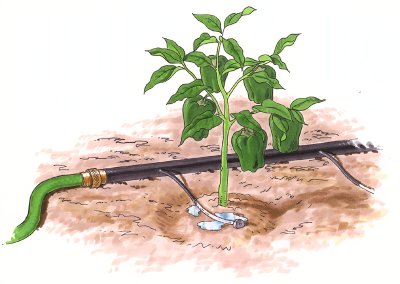At this time of year, when not day-dreaming of being immersed in
a spring-fed watering hole, I am often thinking of the best ways to
keep all of my lovely plants alive.
As gardeners we must try our hardest to conserve as much of our
precious water for our landscapes as possible. Drip irrigation, without
question, is the best way to accomplish this.
The traditional approach has been to use hoses and sprinklers. Then
along came the high-tech underground systems with their automatic
timers, pop-up sprinklers and rotors. All of these simply throw water
in the air in the hope that some of it might benefit the turf, flower-
beds and plants that it lands on.
Drip irrigation, however, is a focused technique that supplies the
right amount of water directly to the plant’s base. Plants love it, and
will show their gratitude by flourishing through these hot summer
months.
To set up a drip system, connect a soft poly pipe to your water faucet,
and run the pipe along the soil surface. The next step is to punch
‘emitters’ into this pipe at the base of each plant. Gardeners often use
mulch to cover the pipe and emitters to further conserve moisture.
__________
Some other benefits of drip irrigation:
1. You save water (and therefore money) since there’s no evaporative
loss to the air. It all goes directly to the plants.
2. Water is added to the soil slowly. This reduces and often elim-
inates water loss due to run off.
3. Weeds don’t get watered as much.
4. Plant diseases, like powdery mildew, are kept at a minimum
because foliage is kept dry.
5. Water can be tailored to individual plant needs. Water loving
plants can be given more by adding extra emitters, while xeri-
scape plants have less.
6. Best of all, drip irrigation is easy to install for both existing flower
beds and vegetable gardens. Often there is no trenching and existing
automatic systems can be adapted easily.
__________
When we combine drip irrigation with native and adaptive plant
species, we can then all make the very best use of water… our most
precious resource.
Happy Gardening everyone!
The training class “How to Plan and Install Home Drip Irrigation”
will be presented from 10 a.m. until noon, Thursday, July 19, at the
Travis County AgriLife Extension Office, 1600 B Smith Rd.



 Visit the website: www.itsaboutthyme.com
Visit the website: www.itsaboutthyme.com